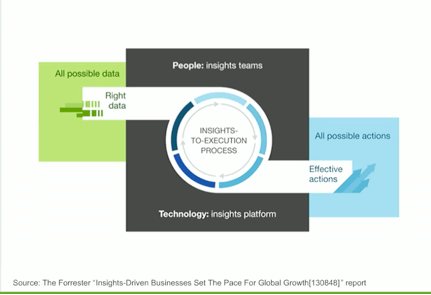Creating Data That Delivers
It’s no secret that data is the secret sauce for marketers. It’s how you accurately measure and monitor campaigns and then demonstrate their value clearly to your executives and stakeholders. And according to Forrester, 78% of firms want to be data driven.1
But data alone doesn’t tell enough of a story to the powers that be. You need to pair that data with analytics and insight that clearly tells the story of the campaign’s value and how that outreach relates to revenue.
You need digital insight, which is actionable knowledge harvested from data analytics —and from people — that’s implemented in software. In other words, it’s not just having the data, it’s also the human implementation of that data. It’s a way to create differentiating experiences, products and services by applying digital insights at scale.2

And there are three distinct ways that analytics and digital insight can help your campaigns and your business: Improved targeting, improved personalization and reduction of waste in marketing efforts and resources. Let’s dive into each one.
Improved Targeting Precision = Better Lift
The requirements for effective customer acquisition demands insight beyond basic business intelligence. Businesses and marketers need a system to help their organization identify, understand and precisely target individuals. This is why 82% of firms will have implemented predictive analytics by the end of 2018.3 By integrating data silos that analyze and learn from each prospect’s activities and behaviors, not only can you offer the most appropriate and relevant experiences delivered over your marketing execution systems, but you can also increase your targeting precision.
Through the use of a Customer Data Platform (CDP) with machine learning, you can intelligently determine the next best action based on your interactions with each customer at each touch point — online and off. When you have an in-depth understanding of each prospect, across all channels, you can also better identify, target and attract new high value customers while achieving a higher ROI on your acquisition marketing spend.
Improved Personalized Content and Offers
With understanding comes precision. Because of all the layers of information known about customers today, it’s surprising that so much of the communications happening between brands and customers are irrelevant to an individual’s wants and needs. Customers know you have their information, which means they have high expectations for you to use that information to enhance their customer experience with relevancy and convenience. They want to feel special and they expect it.
Every customer interaction should be leveraged to evolve into a deeper understanding of that customer. These individual interactions enable you to provide the one-to-one relationship building customers are seeking. This will then allow you to treat that customer accordingly at the next moment of engagement, creating this more personalized experience and most likely, driving sales.
With actionable data, what we call Customer DNA, many opportunities for valuating customer data become reality. Customers can receive an optimized experience, more relevant and consistent, across all channels. And personalized service can be adapted to their present needs and interests, while tied to the complete customer context – their location, most recent purchases, complaints, etc.
Avoided Waste in Marketing Efforts/Resources
Another value of customer data can be about optimum marketing results. Because every time you interact with your customer, through any channel, you have the opportunity to extend the relationship and deliver something relevant for an overall superior customer experience.

From more precise targeting to a more focused money spend, data offers you the ability to acquire the right customers, provide them with excellent service and products, and be more focused on which customers to retain, at what cost.
According to a Gartner survey of CMOs, it’s important to recognize that not all of your existing customers are the right customers — different customers have different value profiles. Valuable marketing budget may be diverted to nurturing the wrong customers — those that are a long-term drag on profitability because they buy low-margin products, buy only when they’re offered promotional pricing or have high servicing costs. The right first-party data and analytics can help mitigate barking up the wrong spending tree.
A CDP allows you to share these customer insights with multiple customer-centric departments and programs, saving time, increasing consistency and accuracy of customer relationship efforts, and empowering you to support finer, more granular customer understanding. Because when you know your customers better, you have the ability to make each opportunity to interact that much more effective, impressive and impactful. From who to up- or cross-sell to, and who already has certain products and services, to who is about to churn, who has become inactive, or who is really a happy, satisfied customer.
How are you using data and analytics to deliver connected experiences along the entire customer journey? And moreover, how is that impacting your bottom line?
- Forrester’s 2018 Business Technographic Data and Analytics Survey
- The Forrester “Insights –Driven Business Set the Pace for Global Growth” report
- Forrester’s 2018 Business Technographic Data and Analytics Survey




